Databricks Agent Bricks is a platform for constructing, evaluating, and deploying production-grade AI brokers for enterprise workflows. Our objective is to assist prospects obtain the optimum high quality–price stability on the Pareto frontier for his or her domain-specific duties, and to constantly enhance their brokers that purpose on their very own information. To help this, we develop enterprise-centric benchmarks and run empirical evaluations on brokers that measure accuracy and serving effectivity, reflecting actual tradeoffs enterprises face in manufacturing.
Inside our broader agent optimization toolkit, this put up focuses on automated immediate optimization, a way that leverages iterative, structured search guided by suggestions alerts from analysis to mechanically enhance prompts. We exhibit how we are able to:
- Allow open-source fashions to surpass frontier-model high quality for enterprise duties: leveraging GEPA, a newly-released immediate optimization method popping out of analysis from Databricks and UC Berkeley, we current how gpt-oss-120b surpasses state-of-the-art proprietary fashions Claude Sonnet 4 and Claude Opus 4.1 by ~3% whereas being roughly 20x and 90x cheaper to serve, respectively (see Pareto frontier plot under).
- Carry proprietary frontier fashions even greater: we apply the identical method to main proprietary fashions, elevating Claude Opus 4.1 and Claude Sonnet 4 baseline efficiency by 6-7% and attaining new state-of-the-art efficiency.
- Provide a superior quality-cost tradeoff in comparison with SFT: automated immediate optimization delivers efficiency on par with, or higher than, supervised fine-tuning (SFT), whereas decreasing serving prices by 20%. We additionally present that immediate optimization and SFT can work collectively to carry the efficiency additional.
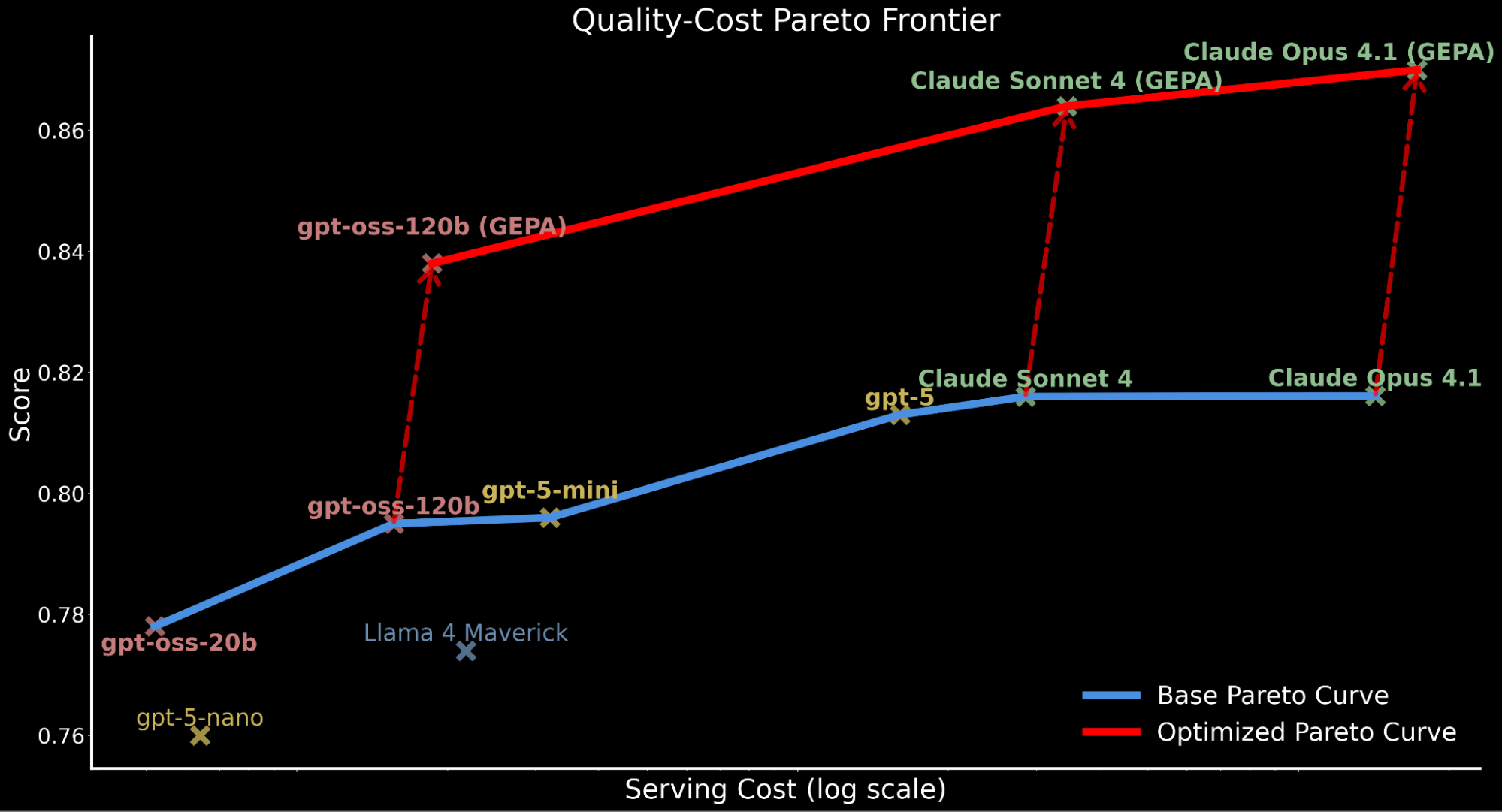
Within the sections that comply with, we’ll cowl
- how we consider AI agent efficiency on info extraction as a core use case and why it issues for enterprise workflows;
- an outline of how immediate optimization works, the sorts of advantages it could actually unlock, particularly in situations the place finetuning isn’t sensible, and efficiency features on our analysis pipeline;
- to place these features in context, we’ll measure the influence of immediate optimization, and analyze the economics behind these methods;
- efficiency comparability with supervised finetuning (SFT), highlighting the superior quality-cost tradeoff by immediate optimization;
- takeaways and subsequent steps, notably how one can get began making use of these methods immediately with Databricks Agent Bricks to construct the best-in-class AI brokers optimized for real-world enterprise deployment.
Analysis of the newest LLMs on IE Bench
Info Extraction (IE) is a core Agent Bricks characteristic, changing unstructured sources similar to PDFs or scanned paperwork into structured data. Regardless of fast progress in generative AI capabilities, IE stays tough at enterprise scale:
- Paperwork are prolonged and crammed with domain-specific jargon
- Schemas are complicated, hierarchical, and include ambiguities
- Labels are sometimes noisy and inconsistent
- Operational tolerance for error in extraction is low
- Requirement of excessive reliability and value effectivity for giant inference workloads
Consequently, we observe that efficiency can fluctuate broadly by area and job complexity, so constructing the proper compound AI techniques for IE throughout various use circumstances requires an intensive analysis of various AI agent capabilities.
To discover this, we developed IE Bench, a complete analysis suite spanning a number of real-world enterprise domains like finance, authorized, commerce, and healthcare. The benchmark displays complicated real-world challenges, together with paperwork exceeding 100 pages, spanning extraction entities with over 70 fields, and hierarchical schemas with a number of nested ranges. We report evaluations on the benchmark’s held-out take a look at set to supply a dependable measure of real-world efficiency.
We benchmarked the newest technology of open-source fashions served through the Databricks Basis Fashions API, together with the newly launched gpt-oss collection, in addition to main proprietary fashions from a number of suppliers, together with the newest GPT-5 household.1
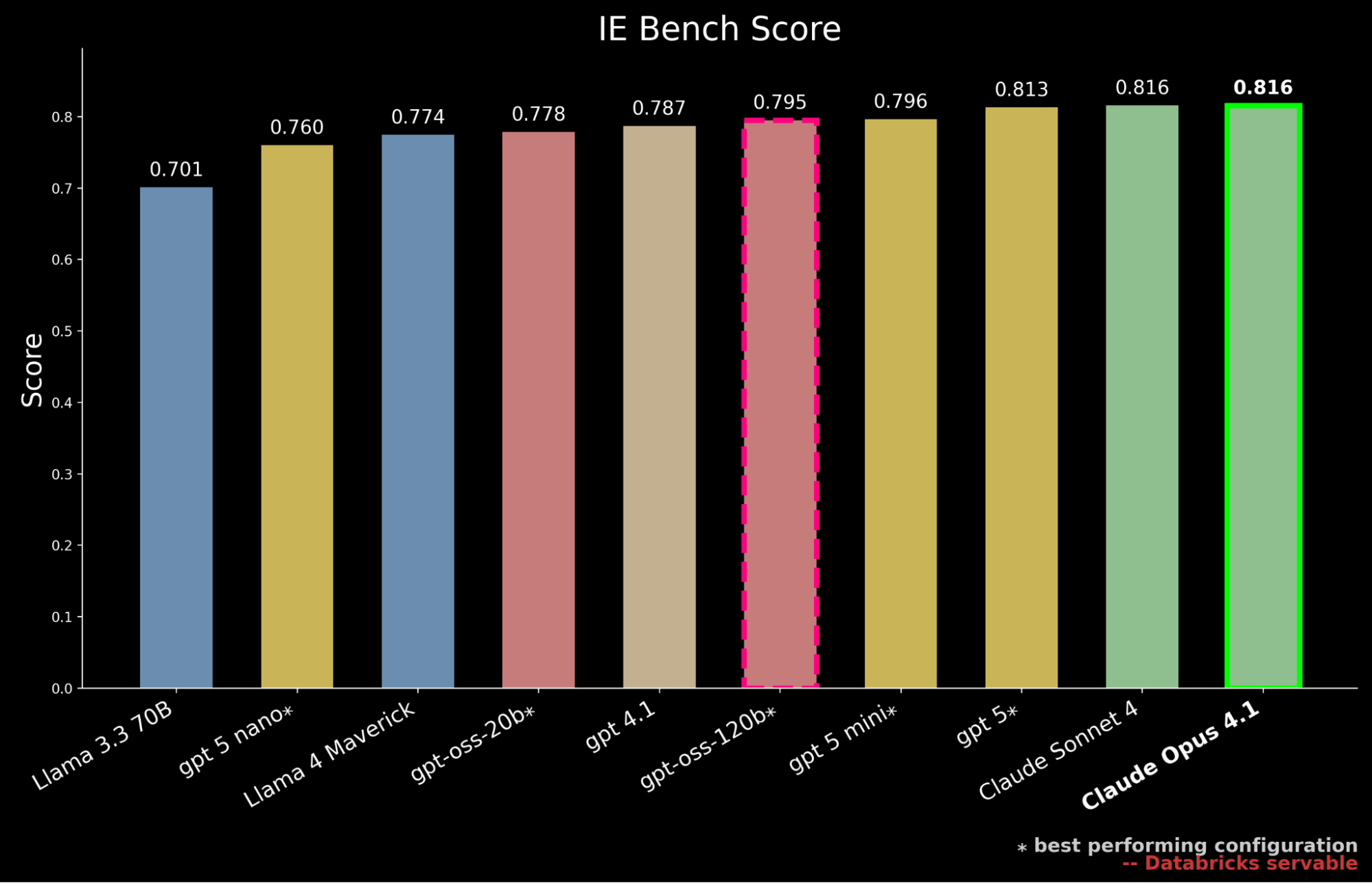
Our outcomes present that gpt-oss-120b is the best performing open-source mannequin on IE Bench, surpassing beforehand open-source state-of-the-art efficiency from Llama 4 Maverick by ~3% whereas approaching the efficiency stage of gpt-5-mini, marking a significant step ahead for open-source fashions. Nevertheless, it nonetheless falls behind proprietary frontier mannequin efficiency, trailing gpt-5, Claude Sonnet 4, and Claude Opus 4.1—which achieves the best rating on the benchmark.
But in enterprise settings, efficiency should even be weighed in opposition to serving price. We additional contextualize our earlier findings by highlighting that gpt-oss-120b matches the efficiency of gpt-5-mini whereas solely incurring roughly 50% of the serving price. 2 Proprietary frontier fashions are largely costlier with gpt-5 at ~10x the serving price of gpt-oss-120b, Claude Sonnet 4 at ~20x and Claude Opus 4.1 at ~90x.
For example the quality-cost tradeoff throughout fashions, we plot the Pareto frontier under, depicting the baseline efficiency for all fashions previous to any enhancements..
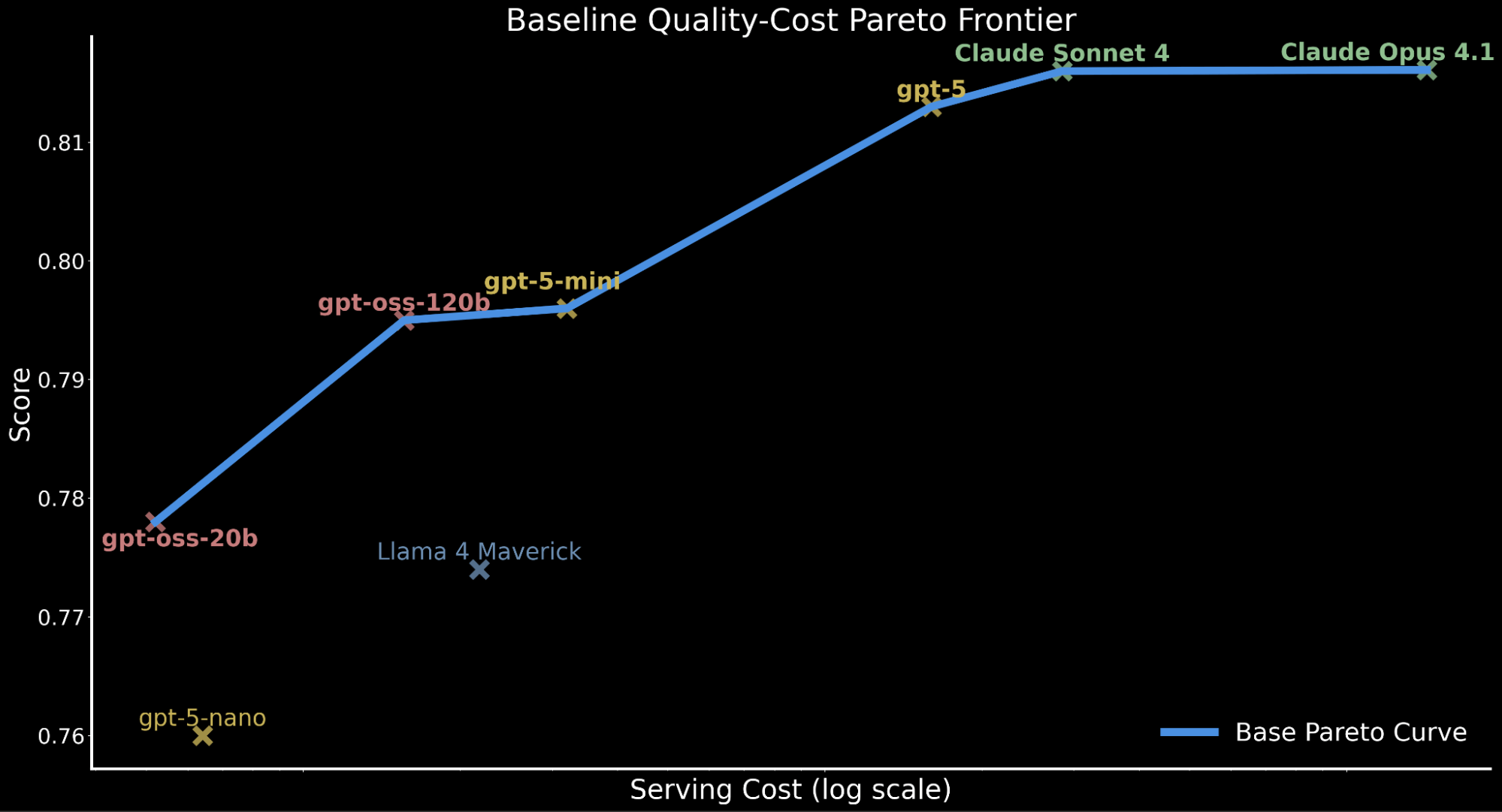
This quality-cost tradeoff has main implications for enterprise workloads requiring large-scale inference that should contemplate compute finances and serving throughput whereas sustaining performant accuracy.
This motivates our exploration: Can we push gpt-oss-120b to frontier-level high quality whereas preserving its price effectivity? In that case, this may ship main efficiency on the cost-quality Pareto frontier whereas being servable for enterprise adoption at Databricks.
Optimizing open-source fashions to outperform frontier mannequin efficiency
We discover automated immediate optimization as a scientific technique for elevating mannequin efficiency. Guide immediate engineering can ship features, nevertheless it usually depends upon area experience and trial-and-error experimentation. This complexity grows additional in compound AI techniques integrating a number of LLM calls and exterior instruments that should be optimized collectively, making guide immediate tuning impractical to scale or preserve throughout manufacturing pipelines.
Immediate optimization provides a unique method, leveraging structured search guided by suggestions alerts to mechanically enhance prompts. Such optimizers are pipeline-agnostic and are capable of collectively optimize a number of interdependent prompts in multi-stage pipelines, making these methods strong and adaptable throughout compound AI techniques and various duties.
To check this, we apply automated immediate optimization algorithms, particularly MIPROv2, SIMBA, and GEPA, a brand new immediate optimizer popping out of analysis from Databricks and UC Berkeley that mixes language-based reflection with evolutionary search to enhance AI techniques. We apply these algorithms to judge how optimized prompting can shut the hole between the best-performing open-source mannequin, gpt-oss-120b, and state-of-the-art closed-source frontier fashions.
We contemplate the next configurations of automated immediate optimizers in our exploration
Every immediate optimization method depends on an optimizer mannequin to refine completely different facets of the immediate for a goal pupil mannequin. Relying on the algorithm, the optimizer mannequin can generate few-shot examples from bootstrapped traces to use in-context studying and/or suggest and enhance the duty directions by search algorithms that carry out iterative reflection utilizing suggestions to mutate and choose higher prompts throughout optimization trials. These insights are distilled into improved prompts for the scholar mannequin to make use of throughout inference time at serving. Whereas the identical LLM can be utilized for each roles, we additionally experiment with utilizing a “stronger-performing mannequin” because the optimizer mannequin to discover if higher-quality steering can additional enhance the pupil mannequin efficiency.
Constructing on our earlier findings of gpt-oss-120b because the main open-source mannequin on IE Bench, we contemplate it our pupil mannequin baseline to discover additional enhancements.
When optimizing gpt-oss-120b, we contemplate two configurations:
- gpt-oss-120b (optimizer) → gpt-oss-120b (pupil)
- Claude Sonnet 4 (optimizer) → gpt-oss-120b (pupil)
Since Claude Sonnet 4 achieves main efficiency on IE Bench over gpt-oss-120b, and is comparatively cheaper in comparison with Claude Opus 4.1 with comparable efficiency, we discover the speculation of whether or not making use of a stronger optimizer mannequin can produce higher efficiency for gpt-oss-120b.
We consider every configuration throughout the optimization methods and evaluate with the respective gpt-oss-120b baseline:
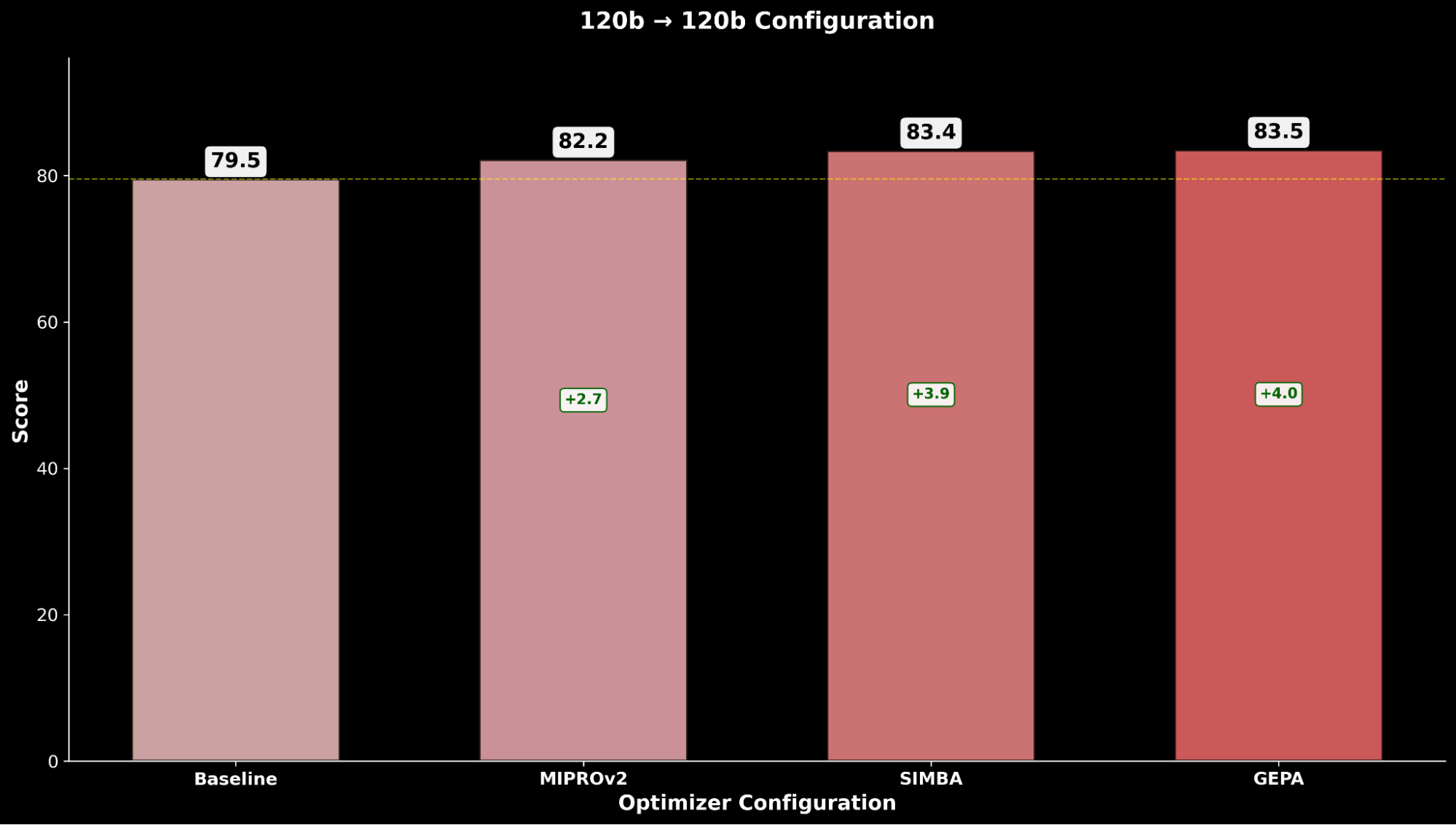
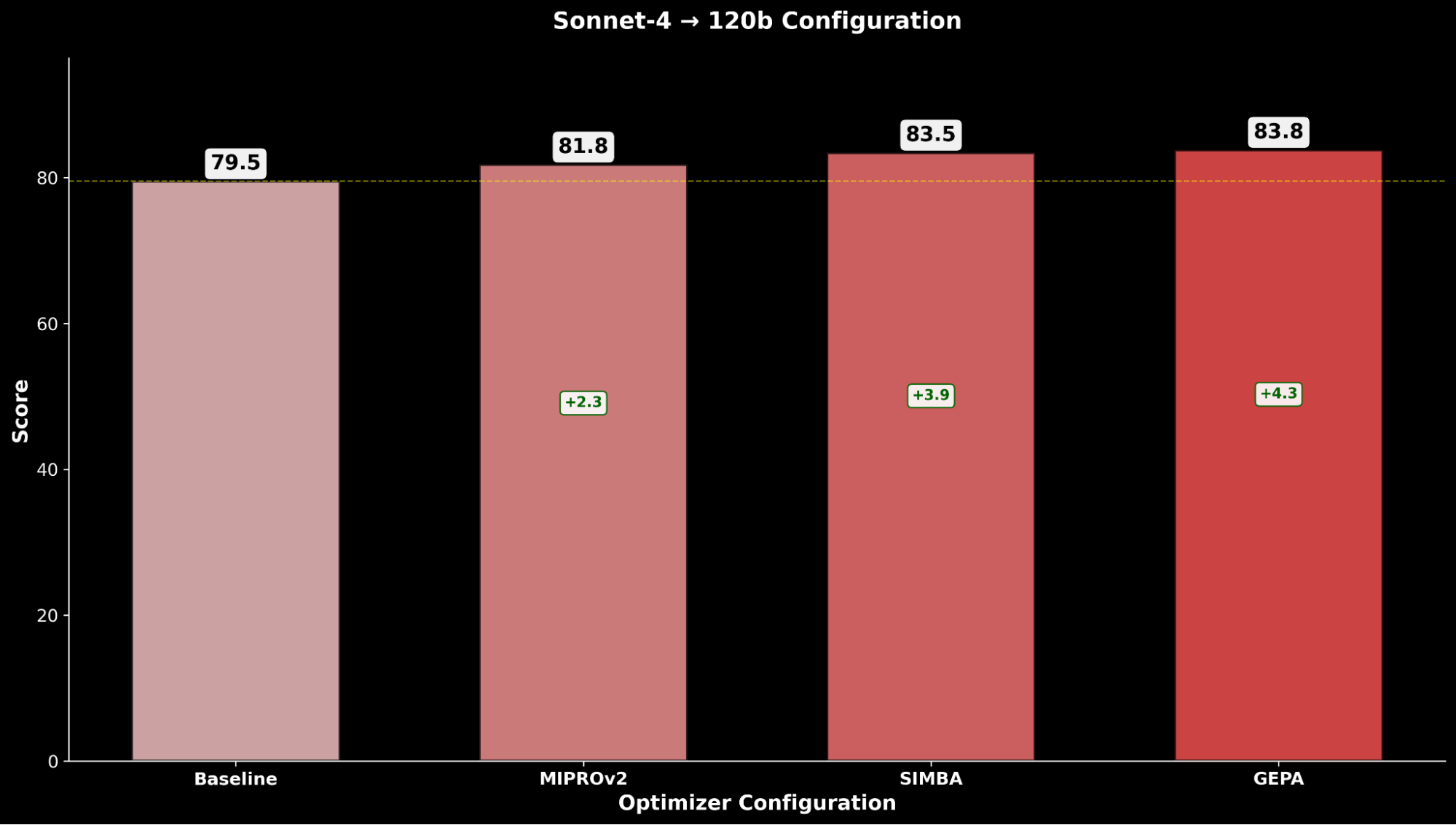
Throughout IE Bench, we discover that optimizing gpt-oss-120b with Claude Sonnet 4 because the optimizer mannequin achieves essentially the most enchancment over baseline efficiency of gpt-oss-120b, with a big +4.3 level enchancment over the baseline and a +0.3 level enchancment over optimizing gpt-oss-120b with itself because the optimizer mannequin, highlighting carry by the usage of a stronger optimizer mannequin.
We evaluate the best-performing GEPA-optimized gpt-oss-120b configuration in opposition to the frontier Claude fashions:
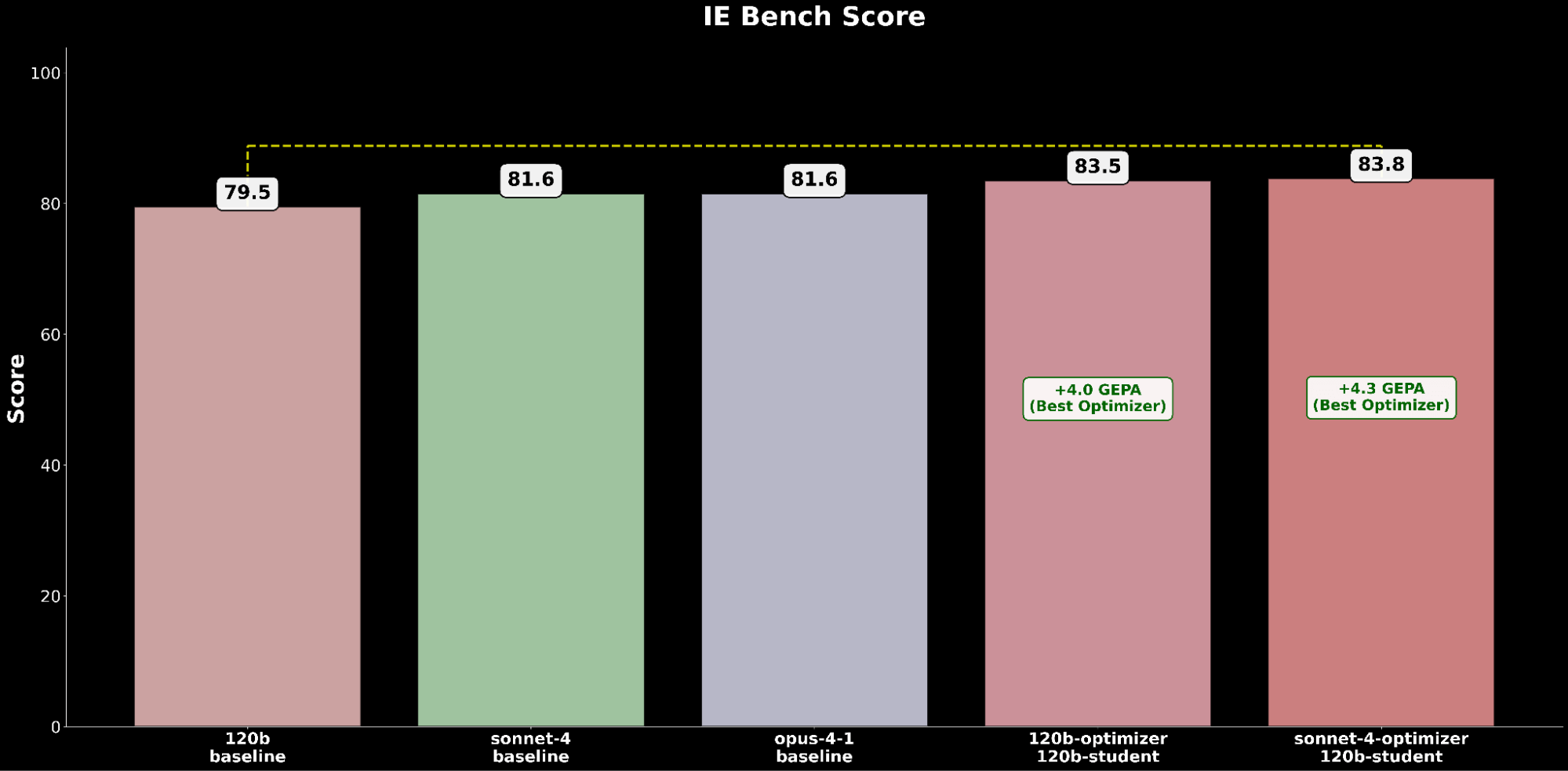
The optimized gpt-oss-120b configuration outperforms the state-of-the-art baseline efficiency of Claude Opus 4.1 by a +2.2 absolute acquire, highlighting the advantages of automated immediate optimization in elevating an open-source mannequin to outperform main proprietary fashions on IE capabilities.
Optimize frontier fashions to additional increase efficiency ceiling
As we see the importance of automated immediate optimization, we discover whether or not making use of the identical precept to the main frontier fashions Claude Sonnet 4 and Claude Opus 4.1 can additional push the achievable efficiency frontier for IE Bench.
When optimizing every proprietary mannequin, we contemplate the next configurations:
- Claude Sonnet 4 (optimizer) → Claude Sonnet 4 (pupil)
- Claude Opus 4.1 (optimizer) → Claude Opus 4.1 (pupil)
We select to think about the default optimizer mannequin configurations as these fashions already outline the efficiency frontier.
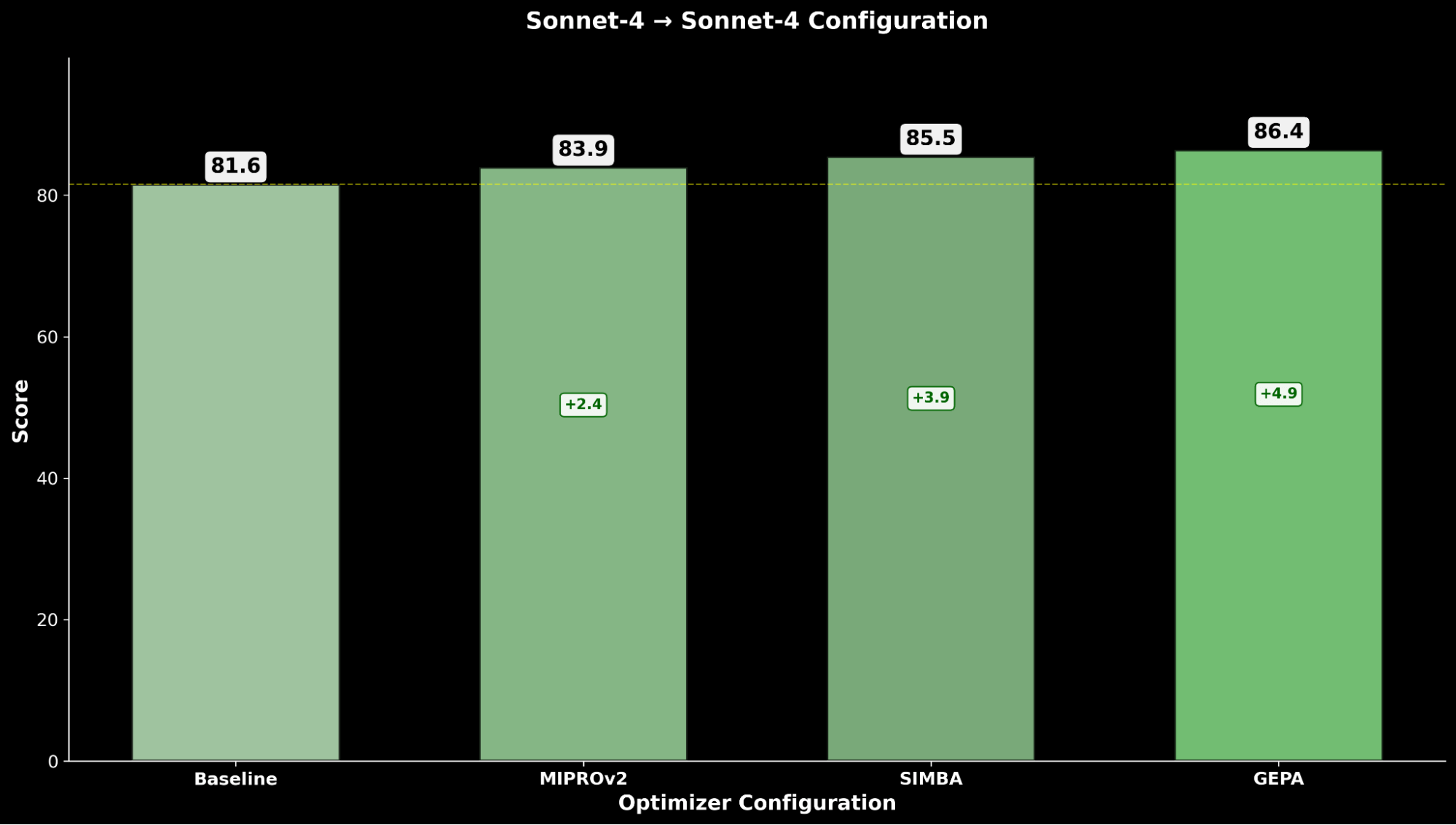
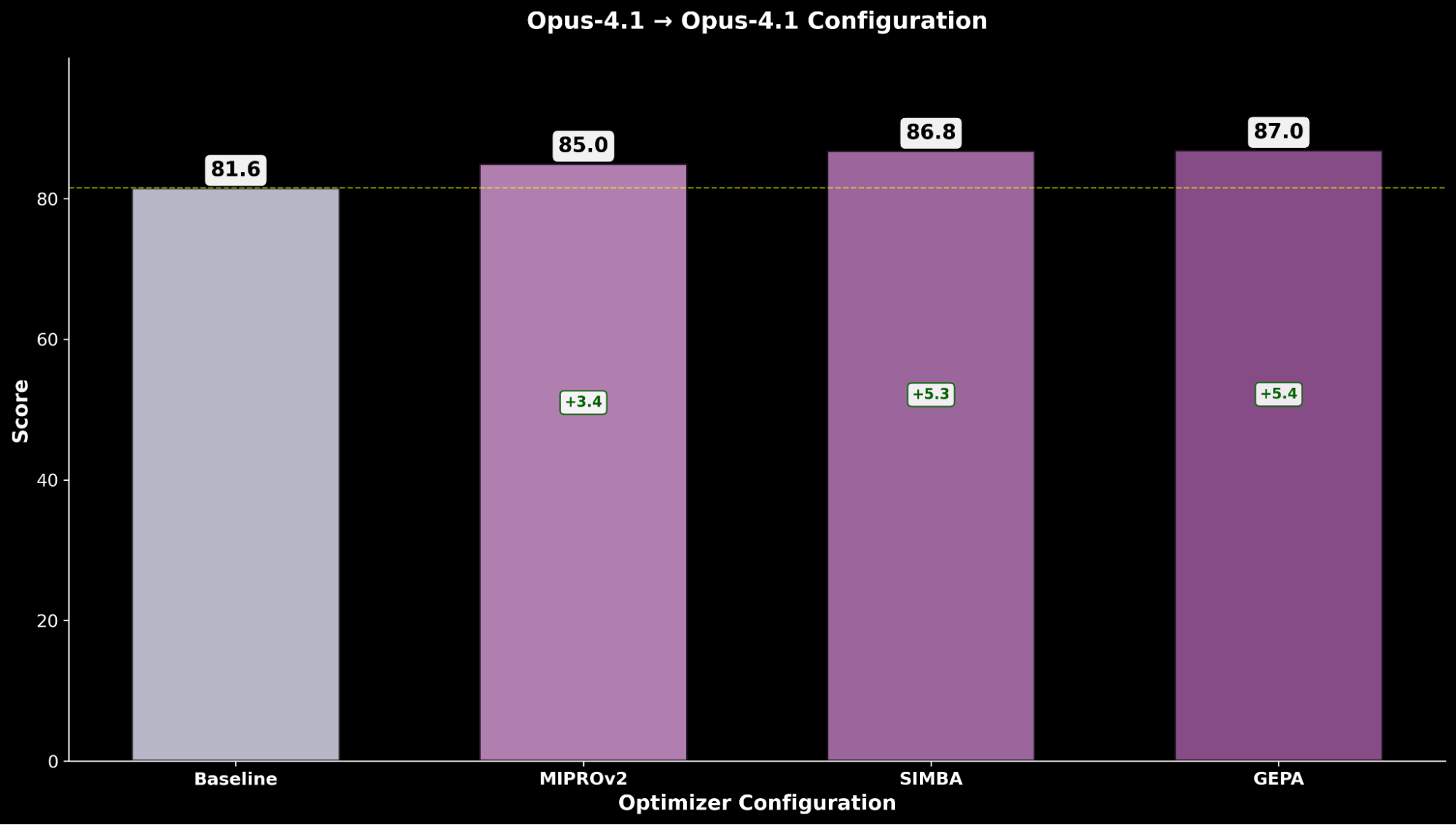
Optimizing Claude Sonnet 4 achieves a +4.8 enchancment over the baseline efficiency, whereas optimized Claude Opus 4.1 achieves the general greatest efficiency, with a big +6.4 level enchancment over the earlier state-of-the-art efficiency.
Aggregating experiment outcomes, we observe a constant development of automated immediate optimization delivering substantial efficiency features throughout all fashions’ baseline efficiency.
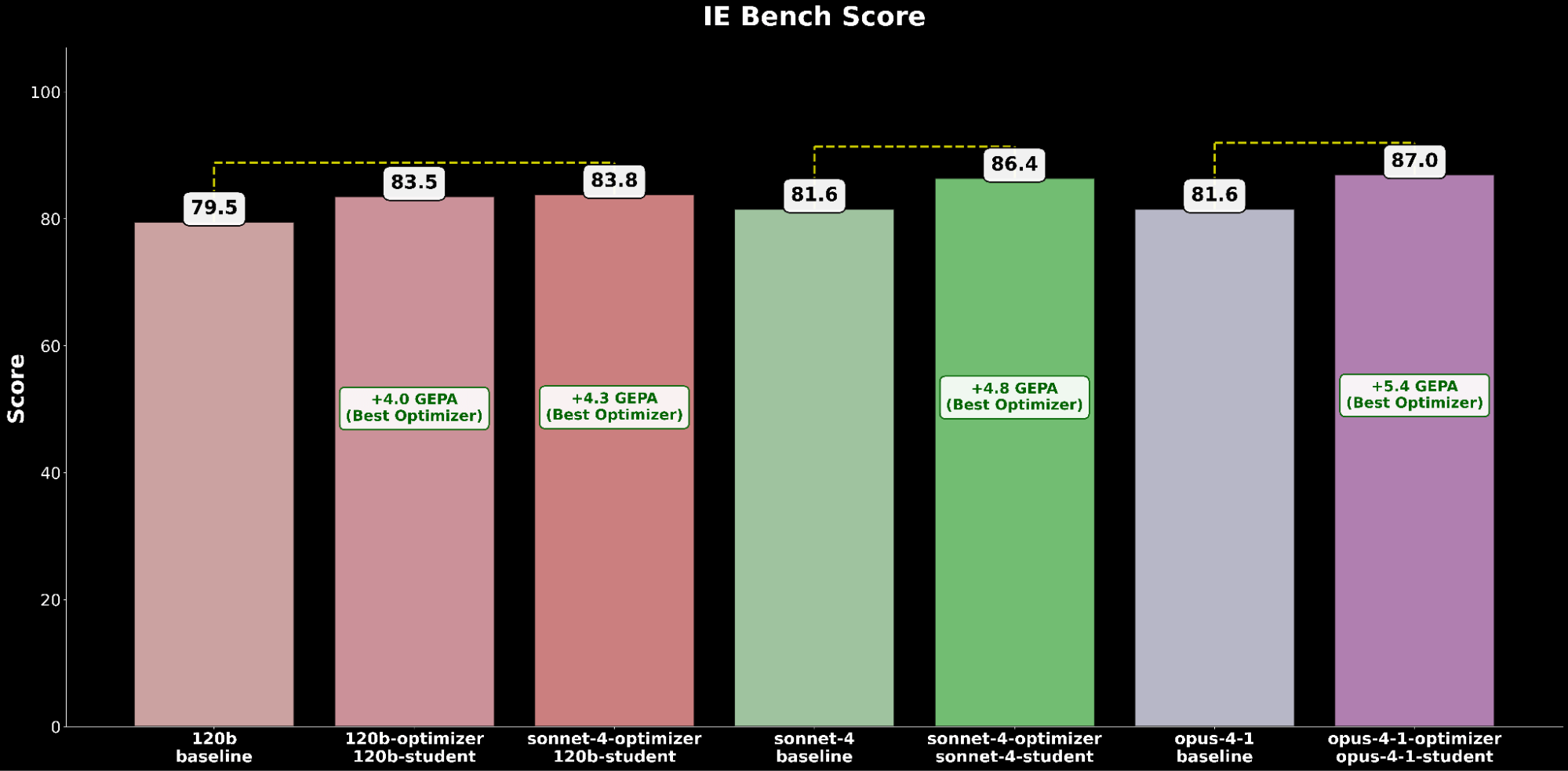
Throughout each open-source and closed-source mannequin evaluations, we persistently discover that GEPA is the highest-performing optimizer, adopted by SIMBA after which MIPRO, unlocking vital high quality features utilizing automated immediate optimization.
Nevertheless, when contemplating price, we observe that GEPA has comparatively greater runtime overhead (because the optimization exploration can tackle the order of O(3x) extra LLM calls (~2-3 hrs) than MIPRO and SIMBA (~1 hr))3 throughout this empirical evaluation of IE Bench. We therefore think about price effectivity and replace our quality-cost Pareto frontier together with the optimized mannequin performances.
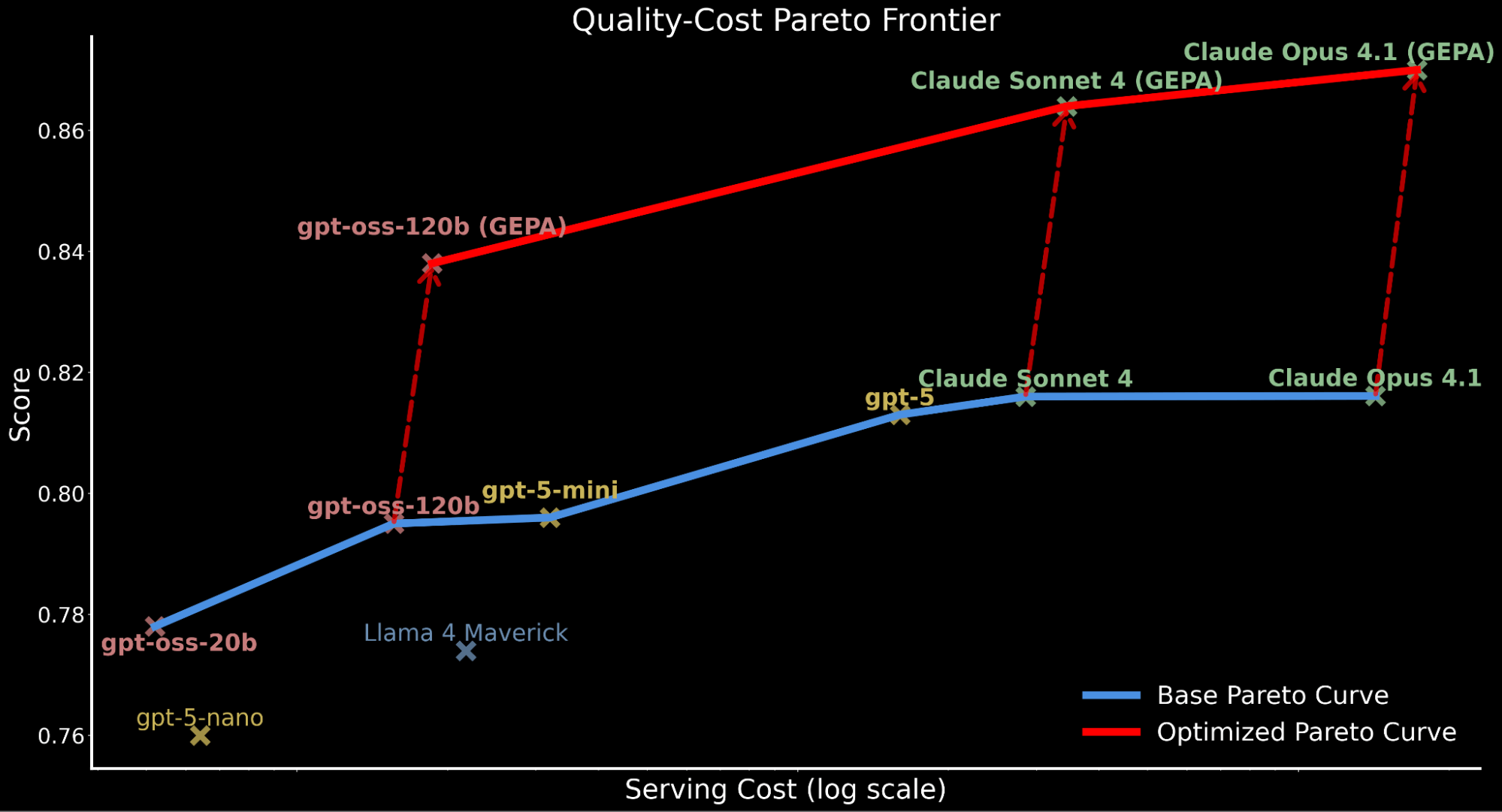
We spotlight how making use of automated immediate optimization shifts your complete Pareto curve upwards, establishing new state-of-the-art effectivity:
- GEPA-optimized gpt-oss-120b surpasses baseline efficiency of Claude Sonnet 4 and Claude Opus 4.1 whereas being 22x and 90x cheaper.
- For purchasers who prioritize high quality over price, GEPA-optimized Claude Opus 4.1 results in new state-of-the-art efficiency, highlighting highly effective features for frontier fashions that can not be finetuned.
- We attribute the accounted whole serving price improve for GEPA-optimized fashions to the longer, extra detailed prompts in comparison with the baseline immediate produced by optimization
By making use of automated immediate optimizations to brokers, we showcase an answer that delivers on Agent Bricks’ core rules of excessive efficiency and value effectivity.
Comparability with SFT
Supervised Superb-Tuning (SFT) is usually thought-about the default technique for enhancing mannequin efficiency, however how does it evaluate to automated immediate optimization
To reply this, we performed an experiment on a subset of IE Bench, selecting gpt 4.1 to judge SFT and automatic immediate optimization efficiency (We exclude gpt-oss and gpt-5 from these comparisons because the fashions weren’t launched on the time of analysis).
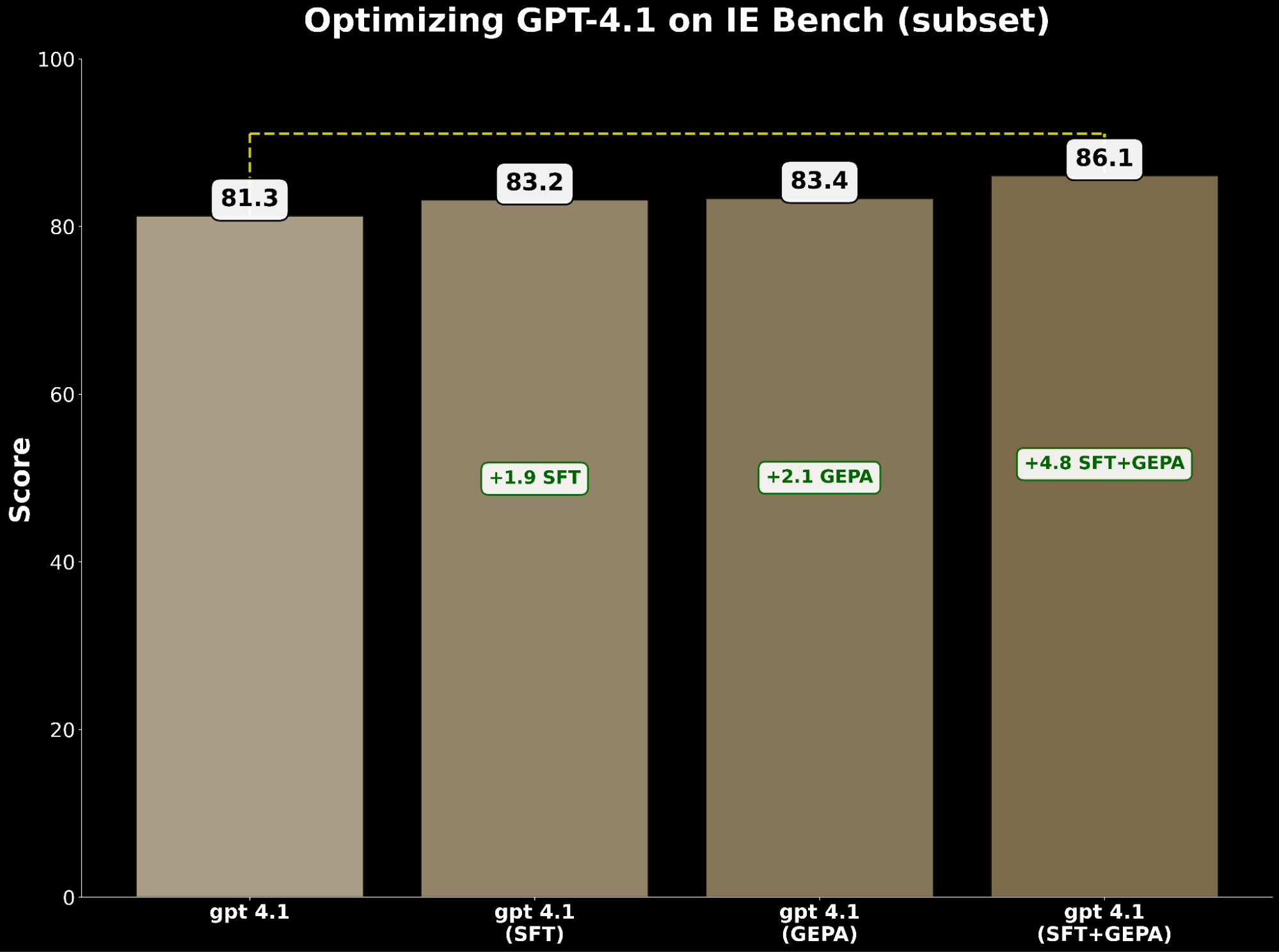
Each SFT and immediate optimization independently enhance gpt-4.1. Particularly:
- SFT gpt-4.1 gained +1.9 factors over baseline.
- GEPA-optimized gpt-4.1 gained +2.1 factors, barely exceeding SFT.
This demonstrates that immediate optimization can match—and even surpass—the enhancements of supervised fine-tuning.
Impressed by BetterTogether, a way that considers alternating immediate optimization and mannequin weight finetuning to enhance LLM efficiency, we apply GEPA on prime of SFT and obtain a +4.8 level acquire over the baseline—highlighting the sturdy potential of compounding these methods collectively.
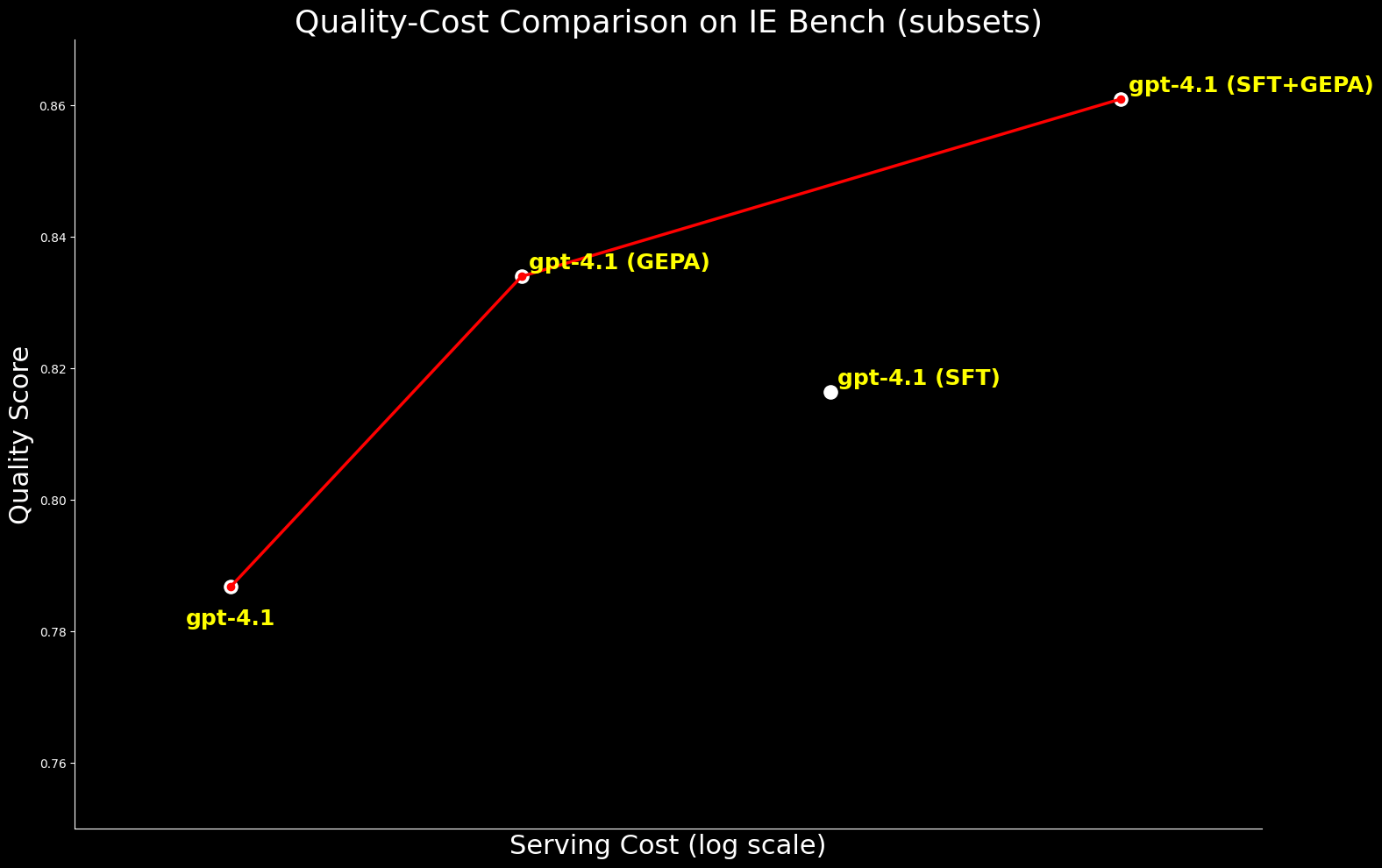
From a price perspective, GEPA-optimized gpt-4.1 is ~20% cheaper to serve than SFT-optimized gpt-4.1, whereas delivering higher high quality. This highlights that GEPA provides a premium quality-cost stability over SFT. Moreover, we are able to maximize absolute high quality by combining GEPA with SFT which performs 2.7% over SFT alone however comes at a ~22% greater serving price.4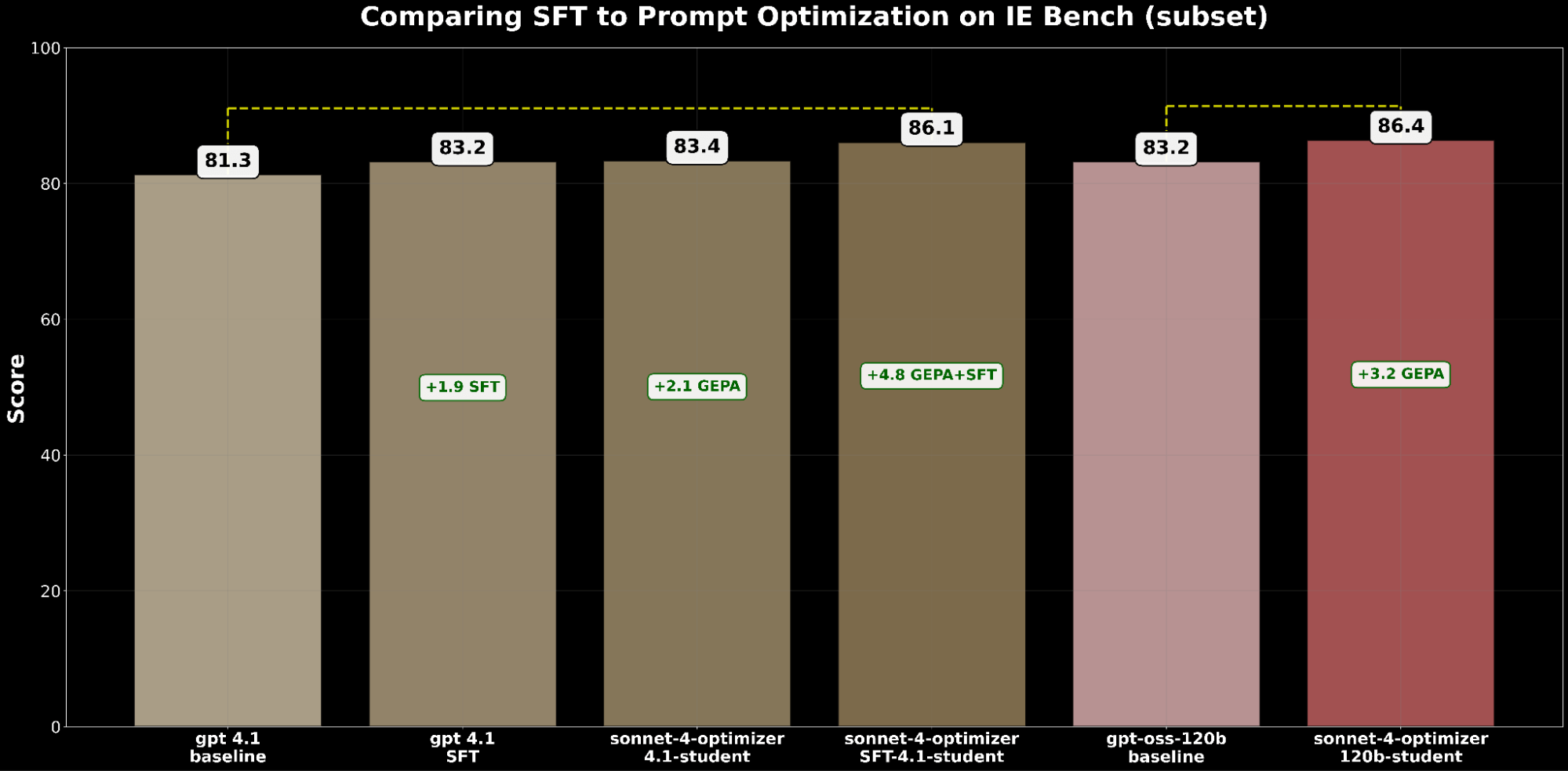
We prolonged the comparability to gpt-oss-120b to look at the standard–price frontier. Whereas SFT+GEPA-optimized gpt-4.1 comes shut—inside 0.3% of the efficiency of GEPA-optimized gpt-oss-120b—the latter delivers the identical high quality at 15× decrease serving price, making it much more sensible and engaging for large-scale deployment.
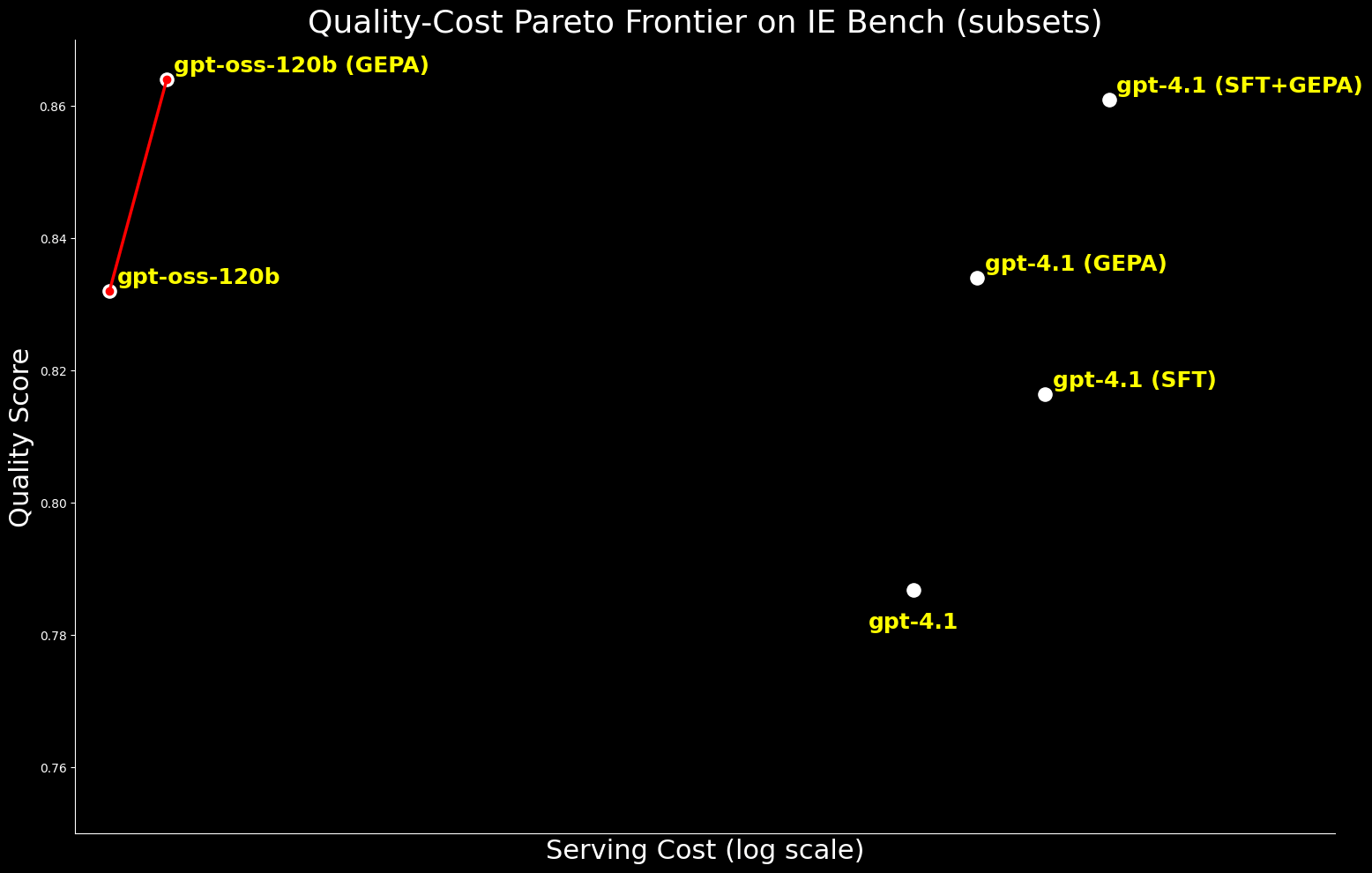
Collectively, these comparisons spotlight the sturdy efficiency features enabled by GEPA optimization — whether or not used alone or together with SFT. Additionally they spotlight the distinctive quality-cost effectivity of gpt-oss-120b when optimized with GEPA.
Lifetime Value
To judge optimization in real-world phrases, we contemplate the lifetime price to prospects. The objective of optimization isn’t solely to enhance accuracy but in addition to supply an environment friendly agent that may serve requests in manufacturing. This makes it important to take a look at each the price of optimization and the price of serving massive volumes of requests.
Within the first plot under, we present the lifetime price of optimizing an agent and serving 100k requests, damaged down into optimization and serving elements. At this scale, serving dominates the general price. Among the many fashions:
- gpt-oss-120b with GEPA is by far essentially the most environment friendly, with prices an order of magnitude decrease for each optimization and serving.
- GPT 4.1 with SFT and Sonnet 4 with GEPA have comparable lifetime price.
- Opus 4.1 with GEPA is the most costly, primarily attributable to its excessive serving value.
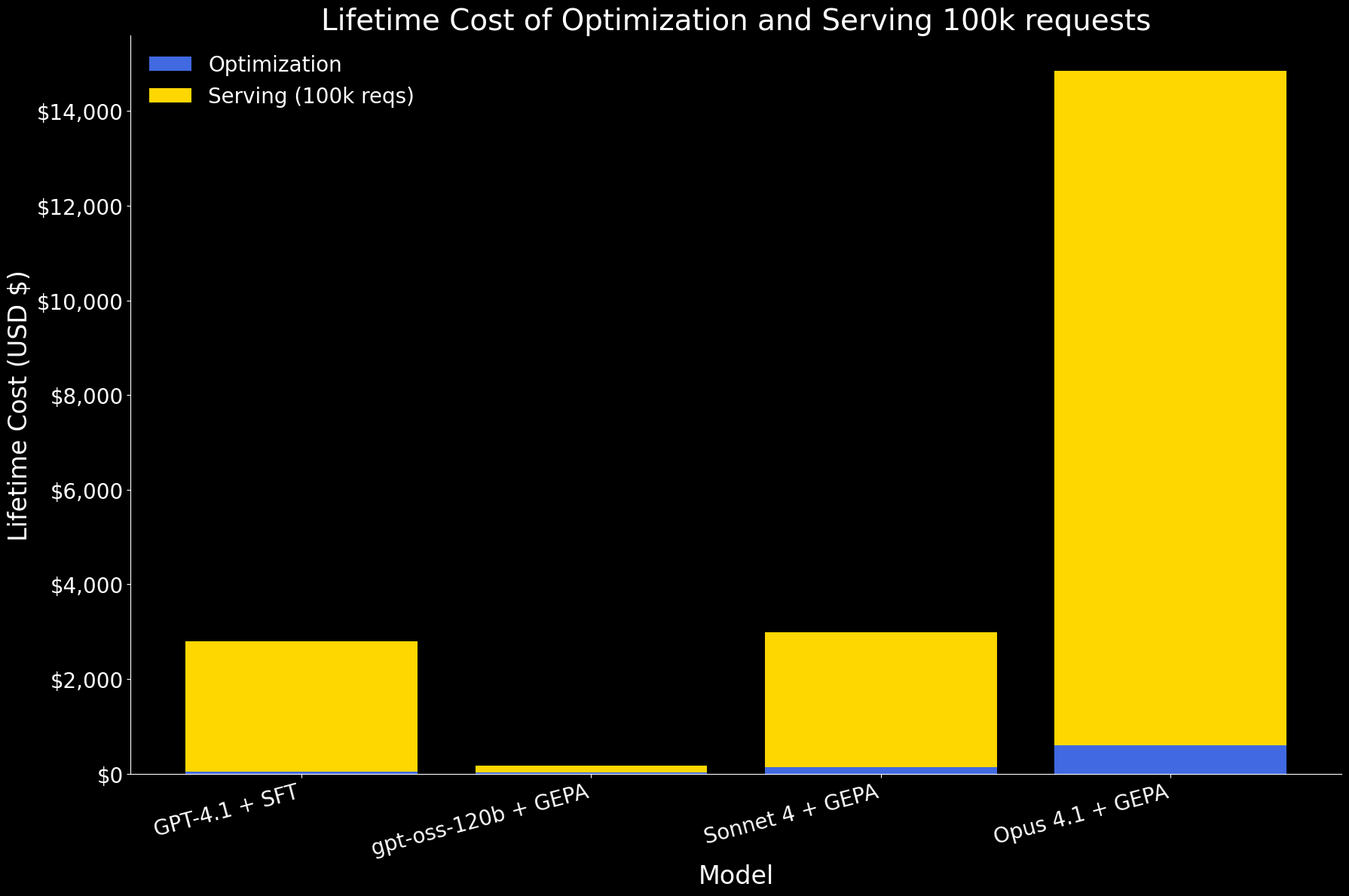
We additionally look at how the ratio of optimization to serving price adjustments at completely different workload scales:
- At 1k serving workloads, serving prices are minimal, so optimization accounts for a big share of the overall price.
- By 100k requests, serving prices develop considerably, and the optimization overhead is amortized. At this scale, the advantage of optimization – higher efficiency at decrease serving price – clearly outweighs its one-time price.
- At 10M requests, optimization prices develop into negligible in comparison with serving prices and are not seen on the chart.
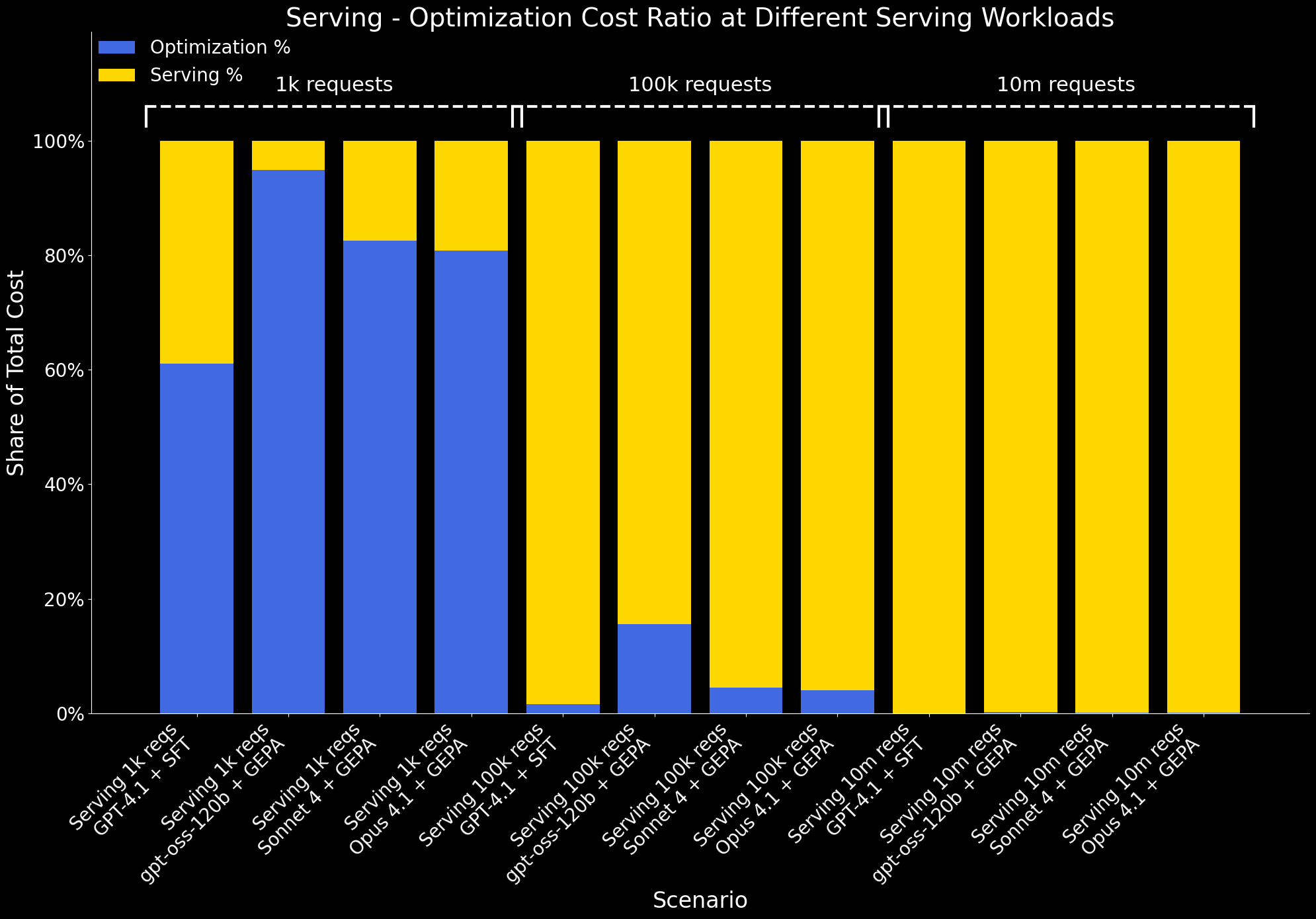
Abstract
On this weblog put up, we demonstrated that automated immediate optimization is a strong lever for advancing LLM efficiency on enterprise AI duties:
- We developed IE Bench, a complete analysis suite spanning real-world domains and capturing complicated info extraction challenges.
- By making use of GEPA automated immediate optimization, we increase the efficiency of the main open-source mannequin gpt-oss-120b to surpass the efficiency of state-of-the-art proprietary mannequin Claude Opus 4.1 by ~3% whereas being 90x cheaper to serve.
- The identical method applies to frontier proprietary fashions, boosting Claude Sonnet 4 and Claude Opus 4.1 by 6-7%.
- Compared to Supervised Superb-Tuning (SFT), GEPA optimization supplies a superior quality-cost tradeoff for enterprise use. It delivers efficiency on par with or surpassing SFT whereas decreasing serving prices by 20%.
- Lifetime price evaluation reveals that when serving at scale (e.g., 100k requests), the one-time optimization overhead is shortly amortized, and the advantages far outweigh the price. Notably, GEPA on gpt-oss-120b delivers an order-of-magnitude decrease lifetime price in comparison with different frontier fashions, making it a extremely engaging alternative for enterprise AI brokers.
Taken collectively, our outcomes present that immediate optimization shifts the standard–price Pareto frontier for enterprise AI techniques, elevating each efficiency and effectivity.
The automated immediate optimization, together with beforehand revealed TAO, RLVR, and ALHF, is now out there in Agent Bricks. The core precept of Agent Bricks is to assist enterprises construct brokers that precisely purpose in your information, and obtain state-of-the-art high quality and cost-efficiency on domain-specific duties. By unifying analysis, automated optimization, and ruled deployment, Agent Bricks allows your brokers to adapt to your information and duties, be taught from suggestions, and constantly enhance in your enterprise domain-specific duties. We encourage prospects to attempt Info Extraction and different Agent Bricks capabilities to optimize brokers to your personal enterprise use circumstances.
1 For each gpt-oss and gpt-5 mannequin collection, we comply with the perfect practices from OpenAI’s Concord format that inserts the goal JSON schema within the developer message to generate structured output.
We additionally ablate over the completely different reasoning efforts for the gpt-oss collection (low, medium, excessive) and gpt-5 collection (minimal, low, medium, excessive), and report the perfect efficiency of every mannequin throughout all reasoning efforts.
2 For serving price estimates, we use revealed pricing from the mannequin suppliers’ platforms (OpenAI and Anthropic for proprietary fashions) and from Synthetic Evaluation for open-source fashions. Prices are calculated by making use of these costs to the enter and output token distributions noticed in IE Bench, giving us the overall price of serving for every mannequin.
3 The precise runtime of the automated immediate optimization is tough to estimate, because it depends upon many elements. Listed here are are giving a tough estimation primarily based on our empirical expertise.
4 We estimate the serving price of SFT gpt-4.1 utilizing OpenAI’s revealed fine-tuned mannequin pricing. For GEPA-optimized fashions, we calculate serving price primarily based on the measured enter and output token utilization of the optimized prompts.

